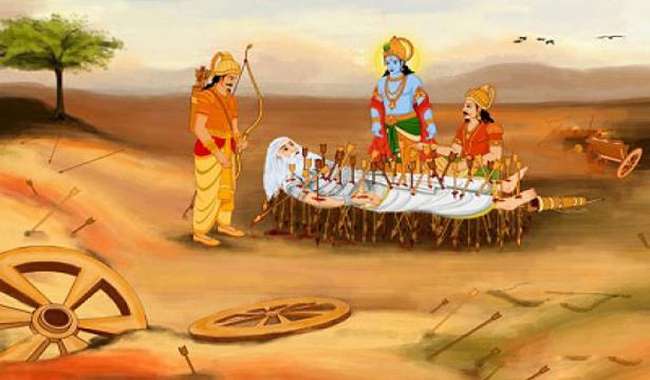Bhishma, the Virtuous:


KK Shanmukhan:
Devrata has been observing the change of mood of his father. He summoned the ministers and the charioteer and questioned them. The prince rode his chariot alone and went straight to the Dasara king. He sought the hands of Satyavati for his father.
“I am very glad to be the father-in-law of the king. I had already told the king of my condition that the son born of my daughter should be the king after Santhanu. But…” He paused and said, “You being the first son the crown will naturally go to you.” “No,” said Devavrata vehemently. “I renounce my right as the heir apparent.”
The enthralled Dasara said, “Son, you are a real hero. Very few on the earth can make such sacrifice as you do here.” He continued, “But there is still one more hurdle.”
“And what is that?”
“It is this.” Said the king of the fisher-folks. “Your sons will naturally be as formidable as you are. If they came to claim the kingdom by force, no one can resist them. It is this that torments me.”
“No,” said Devavratha. “I shall remain unmarried throughout my life.” The fisherman hugged Devavratha with tears of joy and said, “You are a great soul! You are a rare example among men. Please lead my daughter to the king yourself. For this unparalleled stance of yours, you will be known as Bhishma.”
The gods from above poured showers of flowers on his head. Bhishma brought Satyavati home and offered her to his father. King Santhanu could not control his emotions. He hugged his son and with filled heart blessed him to be “Swachantha Mrithyu”, one who can accept death at his will. King Santhanu had two sons from Satyavati – Chitrangada and Vichitraveera. After king Santhanu’s demise, Chitrangada was crowned as king. Although he ruled the kingdom laudably, he could not live longer. In an encounter with a Gandharva of his same name, Chitrangada was annihilated and eventually Vichitraveera became king.
King of Kashi had three daughters of marriageable age – Amba, Ambika and Ambalika. They were very popular among the young princes all over Bharata for their beauty and grace. The king of Kashi fixed their ‘Swayamvara’. All the princes desirous of marrying the damsels would assemble there and the princesses can choose their husbands of their choice. Bhishma decided to bring the girls by force and get Vichitraveera to marry them.
The assembly of princes and the marriageable girls mocked at Bhishma who had proclaimed his celibacy and has come now at this advanced stage of age to seek brides. They scorned him loudly. The enraged Bhishma got up and challenged the entire assembly. The princes under the leadership of prince Salva opposed him. Bhishma fought them all single-handedly and defeated them. Collecting the three princesses he rode over to Hastinapura.
The wedding of the princesses with Vichitraveera was fixed. Amba, the eldest among them came to Bhishma and told him that she was in love with Salva. Bhishma instantly made arrangements for her return to Salva and got the other girls married with Vichitraveera.
Salva did not receive Amba. He was humiliated and defeated by Bhishma in the assembly as also dragged Amba by force. Now there is no question of any rethinking and compromise. She could select her way.
Amba went back to Bhishma. Vichitraveera had no mind to accept her. She had already chosen someone else as her husband. She approached Bhishma. Neither could he help her because he was a sworn celibate. She went to Parasurama, Bhishma’s Acharya in archery. Hearing her pathetic story Parasurama summoned Bhishma and asked him to marry her. This somehow did not work out. There ensued a fight between Parasurama and Bhishma in which the former had to acknowledge peace. Amba meditated on the lord and seeking a blessing for being the cause of death of Bhishma in her next birth, immolated herself in her yogic pyre. Amba was reborn as Sikhandin, a eunuch.
On the tenth day of the Mahabharata war, this unrivalled hero fell down on the battle field struck by Arjuna’s arrows all around. He did not resist Arjuna because Sikhandin, the eunuch was placed in front of Arjuna. It was against the attitude and principle of Bhishma to fight someone, born as a woman. The wrong attitude and the right principle caused Bhishma’s fall! n
